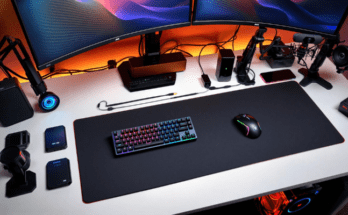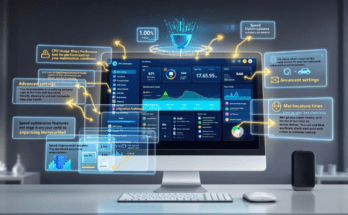Introduction
Looking into the future approximately the year 2025 few changes will be recorded in the world of technologies. As the time passes the computing, artificial intelligence, and interconnected Internet of Things (IoT) are also increasing thus computers are going to get powerful, efficient and smart in the future. Therefore, to prepare for this future, people should look at what are the best computers to be used in 2025? For more detailed information on these concepts and for some ideas of what might be in store for tomorrow’s best computer, read on.
1. Quantum Computing
Most people today are only familiar with classical computing, which is based on the principles of classical physics. A quantum computer, in contrast to the ordinary computer that processes and stores data in bits, uses quantum bits – or qubits. Qubits can be in two states and more at one time making quantum computers solve certain problems much faster than normal ones. For more detail, the selective application will appear in the form of various fields as quantum computers develop, such as finance, medicine, and cybersecurity. More practical and easy to use quantum computers are, therefore, likely to be developed by 2025, and these will be capable of solving problems in the most effective way.
1.1. Quantum Supremacy
In October the Google quantified computer company stated to have attained the quantum supremacy they had claimed by solving a very difficult problem in 200 seconds by use of their quantum computer with fifty-three qubits named Sycamore. Thus, this groundbreaking experimental realization proves that quantum computers can solve some problems much faster than the world fastest supercomputers. It is, however, important to note that whereas quantum supremacy can be considered a reasonable goal, we are yet to achieve real quantum computing. However, more research and development of quantum computers is supposed to come about which will eventually lead to better capabilities and feasibility in developing computing technology.
1.2. Quantum Computing Advantages
Quantum computers have several advantages over classical computers, including
a) Exponential Speedup: The classical computers are easier than quantum computers for some of the basic computational problems. An example of quantum algorithms to integer factorization is Shor’s algorithm to actually factor these numbers in a polynomial time but classical algorithm currently known for them is super polynomial one.
b) Parallelism: It is possible for quantum computers to perform different results at the times at the same time by being in the state of 0 and 1 at the same time. Indeed, this parallelism can be a good catalyst for attaining astonishing solutions to several problems.
c) Robustness: Quantum computers are opt for against some kinds of errors, which provides for them the greater reliability than classical computers in particular tasks.
1.3. Quantum Computing Challenges
Despite the advantages of quantum computing, several challenges must be addressed before it can become mainstream
a) Error Correction: Quantum computers, in particular, are very sensitive to decoherence and noise interference. Proposing good quantum error correction techniques challenges for the creation of robust quantum computers.
b) Scalability: Quantum computer with an in-or hundreds or thousands of qubit are currently a topic of discussion in the technological constraints and the fact that coherence and control have to be attained at large scales.
c) Algorithm Development: Many quantum algorithms are still in the theoretical stage and ad hoc algorithms ought to be designed for real applications to harness the benefit of quantum computers.
2. Neuromorphic Computing
Neuromorphic computing is a congener of computing that is modeled after the structure and operation of the brain. Conventional computers are utilized by conventional computers, in the von Neumann model with clear processor and memory separation, whereas neuromorphic computers use SNNs for both processing and memory. Artificial neurons and synapses in these networks mimic with real neurons and synapses wherein real data is processed far more efficiently. By 2025, we expect neuromorphic computers to be used in autonomous vehicles, robotics and edge computing.
2.1. Neuromorphic Computing Advantages
Neuromorphic computing has several advantages, including
a) Energy Efficiency: As compared to classical computing architecture, neuromorphic computing architecture dissipate a very low power, which makes it more suitable for edge computations and battery-operated products.
b) Parallelism: Contemporary neuromorphic PCs can perform independent computations, meaning that they are capable of solving more complicated problems like image and video recognition or speech differentiation faster than PCs that belong to the classical type.
c) Fault Tolerance: It says neuromorphic computers can still operate if some neurons or synapses fail, making it more anti hardware failure.
2.2. Neuromorphic Computing Challenges
Despite the potential benefits of neuromorphic computing, several challenges must be addressed
a) Hardware Development: Designing and implementing functional and highly efficient neuromorphic platforms remains a technical issue owing to the conditions for emulating neurons and synapses.
b) Software Development: The core of the problem is that today we lack programming languages and tools that would enable optimal usage of neuromorphic computers.
c) Algorithm Development: Creating new patterns and structures for ML, best suitable for neuromorphic computing is of paramount importance as these interventions best work in this computational paradigm.
3. Hybrid Cloud Computing
Hybrid cloud computing is known as a diverse and eligible computing model which use both public and private cloud services. Security, lower costs and improved agility are all possible when organizations take advantage of the benefits of private and public cloud simultaneously. By the 2025, it is expected that the hybrid cloud computing will be more popular since organizations will need more of the cloud services than the local computing networks.
3.1. Hybrid Cloud Computing Advantages
Hybrid cloud computing has several advantages, including
a) Scalability: Hybrid cloud computing provides the firm with on-demand Scalability to scale up or scale down the computing resources since it combines the benefits both the public cloud services and private clouds.
b) Cost Efficiency: Hybrid cloud computing can prove advantageous for firms since it can allow the use of one, or more public cloud services and one, or more private cloud services to cut operation expenses when feasible.
c) Flexibility: Hybrid cloud computing allows organizations more leeway as far as their computing resources are concerned because they use the best solutions that are qualified by time and technology.
3.2. Hybrid Cloud Computing Challenges
Despite the benefits of hybrid cloud computing, several challenges must be addressed
a) Complexity: Handling a large number of cloud environments becomes very challenging and can also take a lot of time mostly require professional skill and tools to manage and have them well integrated and running optimally.
b) Security and Compliance: Securing and managing data and application in both the public and private clouds is not always easy, it needs good levels of secure mechanisms and good security control mechanisms.
c) Interoperability: Interoperability between public and private clouds is critical, while its achievement may prove difficult due to technological, API and protocol disparities between that of a private and public cloud.
4. Edge Computing
Refer to edge computing as a distributed computing model that deals with data processing near where the data is collected. Where instead, the data is transported to large data centers or the cloud and processed there, edge computing brings processing to the edge of the network—closer to the end consumers and devices. It can help cut down on a lot of latency issues, enhance system fluidity and act as a foundation for real-time data analysis. As the IoT grows and never in the future do we see applications that demand the real-time processing and analysis of data, edge computing to become more common by 2025.
4.1. Edge Computing Advantages
Edge computing has several advantages, including
a) Low Latency: Users can completely interact with a system and receive immediate answers when data are analyzed at the edge, resulting in low latency.
b) Scalability: High amount of data from IoT devices can be managed through edge computing making it possible to perform scalability analysis on data.
c) Security: In data security edge computing can be applied to enhance the amount of data that is transferred over the network as most computations are performed locally.
4.2. Edge Computing Challenges:
Despite the advantages of edge computing, several challenges must be addressed
a) Interoperability: Because edge devices, platforms, and networks use different technologies, standards, and protocols, there can be a lot of difficulty with interoperability between the various edge devices, platforms, and networks.
b) Energy Consumption: Power control and management of the energy utilized by the geographical edge nodes, and particularly in a scenarios that consider a large number of edge devices, entails the employ of specific effective power control methods and even energy scavenging systems.
c) Skills and Expertise: Expertise on edge computing technologies and platforms is still limited, making its acquisition a complex process for organizations and developers.
Conclusion
At the end of the period of prediction, 2025, the characteristics of computing technology are likely to shift dramatically due to the development and growth of quantum computing, neuromorphic computing, hybrid cloud computing and edge computing. The history shows that these emerging technologies will expand the future of computing architectures to be more efficient and more scalable and secure solutions to computing. In this way, we realize what opportunities and problems these technologies can present in order to be armed with information about the future of computing and create the best computers for use in 2025. Opening a conversation with professionals and educational institutions, we can define the further evolution of these technologies and make the world smarter and more intertwined.



